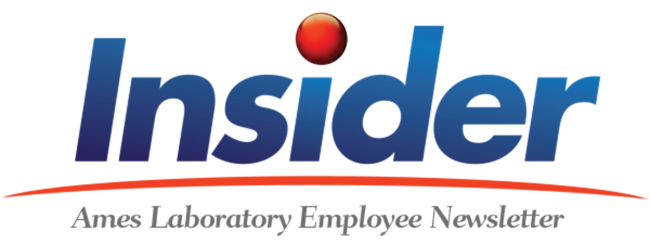
In this issue:
COVID-19 prevention and the holidays
Ames Lab's Rinko appointed to PCAST subcommittee
Reliable quality-control of graphene and other 2D materials is routinely possible
New rules for Sponsored Accounts cyber access
New catalyst mimics natural processes to break down plastic into valuable new products
COVID-19 prevention and the holidays
![]() The fall and winter months on the calendar are full of celebrations that typically involve gathering with family and friends for meals and activities. While these celebrations are not without risk during a typical cold and flu season, the risk is increased as we continue to contend with COVID-19.
The fall and winter months on the calendar are full of celebrations that typically involve gathering with family and friends for meals and activities. While these celebrations are not without risk during a typical cold and flu season, the risk is increased as we continue to contend with COVID-19.
The U.S. Centers for Disease Control (CDC) has resources for dealing with COVID-19 during the holiday months. Some of the highlights have been shared here:
Whether you are hosting or attending a gathering, follow CDC tips for planning gatherings. Below are some additional considerations for holiday celebrations:
- Outdoor activities are preferable to indoor activities. If an outdoor event is not possible, avoid crowded, poorly ventilated, or fully enclosed indoor spaces.
- Limit participants to people from your local area as much as possible.
- Limit the number of attendees as much as possible.
- Provide updated information to guests about any COVID-19 safety guidelines and steps in place to prevent the spread of the virus.
- If you are ill, do not host or attend any gathering.
- Maintain a distance of at least 6 feet or more from people you don’t live with.
- Wear a mask at all times when around people who don’t live in your household to reduce the risk of spreading the virus.
- Wash your hands often with soap and water for at least 20 seconds, especially after you have been in a public place, or after blowing your nose, coughing, or sneezing.
- If you are planning in-person holiday gatherings with people outside of your household, consider asking all guests to strictly avoid contact with people outside of their households for 14 days before the gathering.
- If you participated in higher risk activities or think that you may have been exposed during your celebration, take extra precautions (in addition the ones listed above) for 14 days after the event to protect others:
- Stay home as much as possible.
- Avoid being around people at increased risk for severe illness from COVID-19.
- Consider getting tested for COVID-19.
- If you develop symptoms consistent with COVID-19, such as fever, cough, or shortness of breath, or if you test positive for COVID-19, immediately contact the host and others that attended the event or celebration that you attended. They may need to inform other attendees about their possible exposure to the virus. Contact your health care provider and follow the CDC-recommended steps for what to do if you become sick, and follow the public health recommendations for community-related exposure. If you are waiting for your COVID-19 test results, stay home until you have a result, and follow CDC’s guidance.
Holiday travel and COVID-19
Traveling increases the chance of getting and spreading COVID-19. Staying home is the best way to protect yourself and others. Use information from the following webpages to decide whether to go on holiday travel:
- Travel During the COVID-19 Pandemic
- Know Your Travel Risk
- Know When to Delay Your Travel to Avoid Spreading COVID-19
If you decide to travel, follow these safety measures during your trip to protect yourself and others from COVID-19:
- Wear a mask in public settings, like on public and mass transportation, at events and gatherings, and anywhere you will be around other people.
- Avoid close contact by staying at least 6 feet apart from anyone who is not from your household.
- Wash your hands often with soap and water for at least 20 seconds or use hand sanitizer (with at least 60% alcohol).
- Avoid contact with anyone who is sick.
- Avoid touching your eyes, nose, and mouth.
Ames Lab's Rinko appointed to PCAST subcommittee
Ph.D. candidate Emily Rinko to serve on inaugural SPEC subcommittee advising policymakers on student perspectives
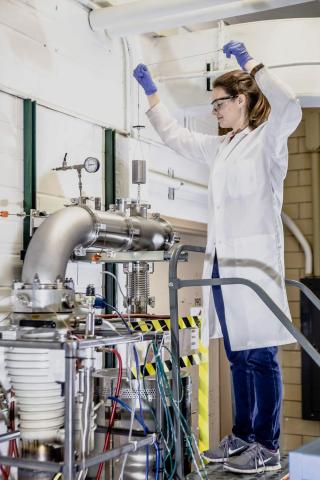
When Ames Laboratory Graduate Research Assistant and Ph.D. candidate Emily Rinko got the call from a Washington, D.C. area-code, she thought it was spam. She didn’t know her name had been submitted for a brand new subcommittee under the President’s Council of Advisors on Science and Technology (PCAST), which would bring on students and early-career scientists to participate in developing PCAST reports and science policy.
The “Students, Post-Doctoral, and Early Career” Subcommittee to PCAST (SPEC) is the first of its kind. Director of The White House Office of Science and Technology Policy Kelvin Droegemeier, Ph.D., spoke about his ambitions for SPEC at the fall American Geophysical Union conference in 2019. “[I created SPEC] because [these individuals] own the future. I miss the intellectual energy postdocs and [other students] bring to the table,” he told an auditorium. He wanted to involve them in the policy that will be affecting thousands of their fellow students and early-career scientists. Their perspective as the people loading the machines with samples, performing the calculations, and monitoring experiments would be invaluable.
After careful consideration, Rinko, who is pursuing a Ph.D. in Materials Science and Engineering at Iowa State University, accepted the nomination. The decision was about service. “I want to help create a positive and supportive environment for future scientists,” noting that her feedback will help make science policy feel more accessible to students like herself, “If you don’t feel like you belong in STEM, you’re not going to do your best work, and that goes for any workplace.” Motivated by her convictions , Rinko was appointed by her fellow SPEC committee members to a leadership position within SPEC. She now serves as Co-Chair of SPEC alongside Dr. Sharon Hrynkow, a PCAST member.
“We are delighted that Emily Rinko has been awarded the honor of participating in the PCAST subcommittee. It is so vital for early-career scientists to develop their leadership skills, and this recognition affirms the excellence we've seen from Emily," said Ames Laboratory Director Adam Schwartz.
While COVID-19 has made the path less straightforward than usual, Rinko and her nine fellow committee members who range from the undergraduate level to the early-career and post-doctoral level have been giving feedback on PCAST's recommendations in its June report. Their perspectives will be used to make policy more agile to scientists at all levels in laboratories across the country.
After falling in love with materials science in the eighth grade, Rinko has had no problem sharing her love of science. In her undergrad, she completed several internships with Lockheed Martin where her work briefly took her within the orbit of the Orion mission, and focused on researching how to make spacecraft materials lighter and stronger.
Rinko is also the vice president of ISU’s Materials Research Society, a member of the Public and Government Affairs and Powder Metallurgy Committees of The Minerals, Materials, and Metals Society (TMS). She came to Iowa State University from Colorado as an undergrad because of its state-of-the-art materials science and engineering program and accessible price tag. She majored in Materials Science and Engineering specializing in ceramics and polymers for her undergraduate degree, and came very close to also specializing in metals, but at the time Rinko found metals “challenging.” It was only natural then, she says, to get a Ph.D. with a focus in metals.
Rinko’s work focuses specifically on AlNiCo (i.e. alnico) magnets. Under the supervision of Iver Anderson, Ph.D., her research pursues a better understanding of new, powder-based alnico magnets, with the larger goal of improving their magnetic properties. She uses compression molding and sintering to make her magnets, both of which are widely-practiced in powder metallurgy industry for part manufacturing.
It would be several milestones for alnico if compression molding can be shown to have competitive or better magnetic properties compared to the best commercially available alnico magnet. First, with its stable temperature performance and strength, it’s possible that alnico could be an alternative to rare earth magnets currently used in a variety of electric machines, such as electric cars, wind turbines, and more. Another benefit is broadening the portfolio of usable permanent magnet types, which means more kinds of electric machine designs. If the lab can make alnico magnets with this technique and if the magnets stay just as strong for just as long, this could have huge implications for the industry and the country - from right here in Iowa.
Rinko sees SPEC involvement as an opportunity to improve her fluency in science policy and broaden her experiences outside of a lab. “I’ve had some exposure to science policy thanks to my involvement in the P&GA TMS subcommittee, but I have never been involved with creating science policy before SPEC,” she said. Now, she’s seen how important collaboration between industry, government, nonprofits and academia is in solving global challenges. “Learning the dialog, priorities, and the logistics of science policy is a great first step at improving my fluency in something that is outside of my field, yet has a lot of influence on it.”
Reliable quality-control of graphene and other 2D materials is routinely possible
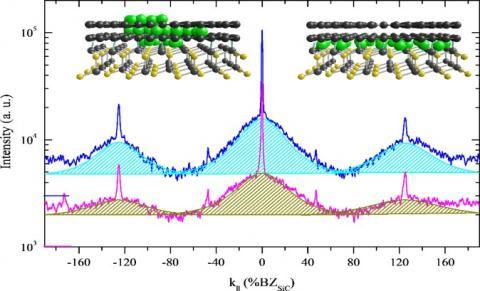
Graphene and other single-atom-thick substances are a category of wonder materials, with researchers the world over investigating their electronic properties for potential applications in technologies as diverse as solar cells, novel semiconductors, sensors, and energy storage.
The greatest challenge for the design of these single-layer or 2D materials into all their myriad potential uses is the need for an atom-by-atom perfection and uniformity that can be difficult and painstaking to achieve at such small scales, and difficult to assess as well.
“We are trying to be more clever than nature in assembling these materials,” said Michael C. Tringides, a senior scientist at the U.S. Department of Energy’s Ames Laboratory and professor of physics at Iowa State University, who investigates the unique properties of 2D materials and metals grown on graphene, graphite, and other carbon coated surfaces. “And to do so, we’re forcing atoms to assemble in ways they normally would not. One of the major challenges of the field is to reliably produce high quality graphene and other materials like it.” READ MORE
New rules for Sponsored Accounts cyber access
Formerly known as the Cyber Only Access form, a Sponsored Account request provides temporary access to Ames Laboratory computing resources. The account is sponsored by a current laboratory employee and provided for individuals who are not employees that have a special need for access. The individual must agree to abide by the Network Rules of Behavior before cyber access will be granted. The account is valid for up to one year.
New catalyst mimics natural processes to break down plastic into valuable new products
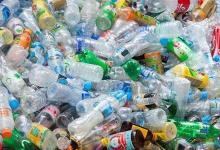 While plastics recycling is not new science, current processes don’t make it economically worthwhile-- waste plastics get “down-cycled” into lower grade, less useful material. It’s a challenge that continues to be an obstacle in tackling a growing global pollution crisis in single use plastics.
While plastics recycling is not new science, current processes don’t make it economically worthwhile-- waste plastics get “down-cycled” into lower grade, less useful material. It’s a challenge that continues to be an obstacle in tackling a growing global pollution crisis in single use plastics.
A multi-institutional team of scientists led by the U.S. Department of Energy’s Ames Laboratory has developed a first-of-its-kind catalyst that is able to process polyolefin plastics such as polyethylene and polypropylene, types of polymers widely used in things like plastic grocery bags, milk jugs, shampoo bottles, toys, and food containers. The process results in uniform, high-quality components that can be used to produce fuels, solvents, and lubricating oils, products that have high value and could potentially turn these and other used plastics into an untapped resource. Read More
New process turns paper manufacturing waste into valuable chemicals
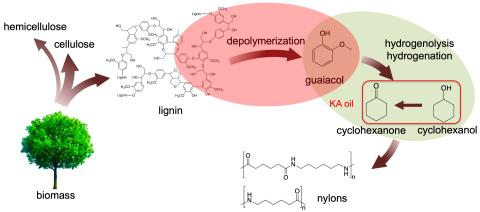 A group of researchers at the U.S. Department of Energy’s Ames Laboratory has discovered a way to convert a common byproduct of the paper manufacturing process into valuable chemical precursors for making nylon. The process is much more environmentally friendly in terms of the solvent(s) used and the energy inputs than other methods and provides a useful alternative to burning waste products of pulping.
A group of researchers at the U.S. Department of Energy’s Ames Laboratory has discovered a way to convert a common byproduct of the paper manufacturing process into valuable chemical precursors for making nylon. The process is much more environmentally friendly in terms of the solvent(s) used and the energy inputs than other methods and provides a useful alternative to burning waste products of pulping.
Kraft (from the German meaning strength) lignin is a major waste product of the paper industry, amounting to about 50 million tons annually. This waste lignin is typically burned for heat, however, that process also releases carbon dioxide into the environment. Read More
DOE Do-It-Yourself Virtual Mile race results
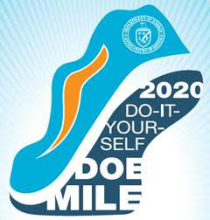 The 2020 Do-It-Yourself Mile took place at the beginning of the month and the results are in! Ten labs across the DOE complex participated in socially-distanced style! Ames brought in 12% of the population for participation with a total of 45 race time submissions (Thanks in part to some beautiful beginning of October weather) this is the highest percent participation for all the labs.
The 2020 Do-It-Yourself Mile took place at the beginning of the month and the results are in! Ten labs across the DOE complex participated in socially-distanced style! Ames brought in 12% of the population for participation with a total of 45 race time submissions (Thanks in part to some beautiful beginning of October weather) this is the highest percent participation for all the labs.
Overall Ames finished 10th in the Men's run, 7th in the Women's run, 5th in the Men's walk, and 8th in the Women's walk. Our top finishers were: William Jenks finished 39th overall in the Men's run, Grace Inman finished 23rd overall for the women's run, Kevin Denis finished 7th overall for the Men's walk, and Jennifer Brockpahler finished 18th overall for the women's walk.
Thank you everyone who participated. Ames lab may be small but we can still be mighty! Full race results can be found HERE.
Insider recognizes passing of Harley Wilhelm
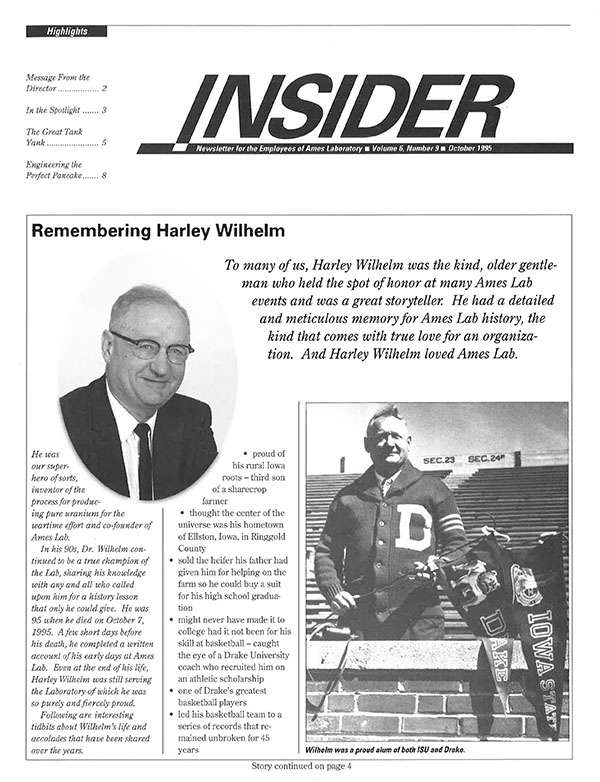 The October 1995 issue of Insider was dedicated to Ames Laboratory pioneer Harley Wilhelm who passed away on Oct. 7, 1995. The tribute included many photos from Wilhelm's life and a list of accomplishments.
The October 1995 issue of Insider was dedicated to Ames Laboratory pioneer Harley Wilhelm who passed away on Oct. 7, 1995. The tribute included many photos from Wilhelm's life and a list of accomplishments.
Elsewhere in the issue, newly appointed Director Tom Barton shared his vision with Lab employees. There were also profiles on Marilyn Kniss and Terry Herrman along with removal of a diesel tank near the Records storage building and a pancake breakfast.
To read the entire issue, click on the cover.
